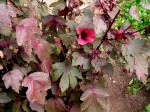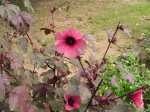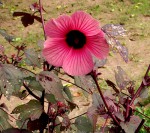Flora of Zimbabwe: Cultivated plants
| Home | > | List of cultivated families | > | Malvaceae subfamily Malvoideae | > | Hibiscus | > | acetosella |
Hibiscus acetosella
Selected images: Click on each image to see a larger version and details of the record View all images (3)
Records: Display species records Map species using Google Maps
Species details: Click on each item to see an explanation of that item (Note: opens a new window)
| Synonyms: | |
| Common names: | Cranberry hibiscus (English) |
| Description: | Annual or perennial herb, sometimes woody below, to 2.5 m; stems without prickles. Stipules linear, not amplexicaul. Leaves: lamina ovate to suborbicular in outline, entire to 3-5-lobed, often red. Flowers up to 10 cm in diameter, solitary, purple-red or lemon-yellow with a purple centre. Epicalyx bracts 9-10, clearly forked. Calyx 10-nerved; lobes triangular, rigid. |
| Notes: | |
| Derivation of specific name: | acetosella:from the taste of the leaves which resembles that of Rumex acetosella). |
| Flowering time: | |
| Worldwide distribution: | Burundi to South Tropical Africa. |
| Growth form(s): | Annual, perennial. |
| Insects associated with this species: | |
| Spot characters: | Display spot characters for this species |
| Literature: |
Burrows, J.E. & Willis, C.K. (eds) (2005). Plants of the Nyika Plateau Southern African Botanical Diversity Network Report No. 31 SABONET, Pretoria Page 203. Chapano, C. & Mugarisanwa, N.H. (2003). Plants of the Matobo District National Herbarium and Botanic Garden, Zimbabwe Page 20. Exell, A.W. (1961). Malvaceae Flora Zambesiaca 1(2) Pages 438 - 439. Mapaura, A. & Timberlake, J. (eds) (2004). A checklist of Zimbabwean vascular plants Southern African Botanical Diversity Network Report No. 33 Sabonet, Pretoria and Harare Page 60. |
Other sources of information about Hibiscus acetosella:
Our websites:
Flora of Burundi: Hibiscus acetosellaFlora of the DRC: Hibiscus acetosella
Flora of Malawi: Hibiscus acetosella
Flora of Zambia: Hibiscus acetosella
Flora of Zimbabwe: Hibiscus acetosella
External websites:
African Plants: A Photo Guide (Senckenberg): Hibiscus acetosellaAfrican Plant Database: Hibiscus acetosella
BHL (Biodiversity Heritage Library): Hibiscus acetosella
EOL (Encyclopedia of Life): Hibiscus acetosella
GBIF (Global Biodiversity Information Facility): Hibiscus acetosella
Google: Web - Images - Scholar
iNaturalist: Hibiscus acetosella
IPNI (International Plant Names Index): Hibiscus acetosella
JSTOR Plant Science: Hibiscus acetosella
Mansfeld World Database of Agricultural and Horticultural Crops: Hibiscus acetosella
Plants of the World Online: Hibiscus acetosella
Tropicos: Hibiscus acetosella
Wikipedia: Hibiscus acetosella
| Home | > | List of cultivated families | > | Malvaceae subfamily Malvoideae | > | Hibiscus | > | acetosella |


